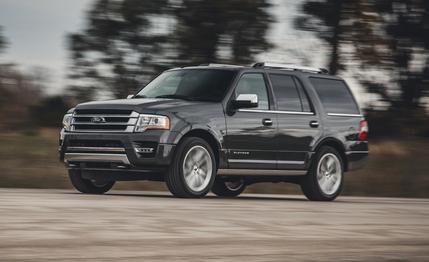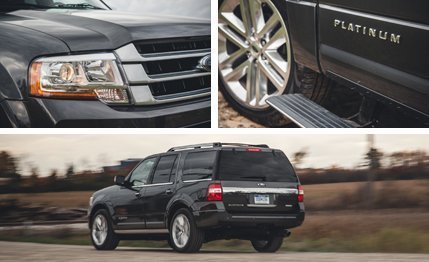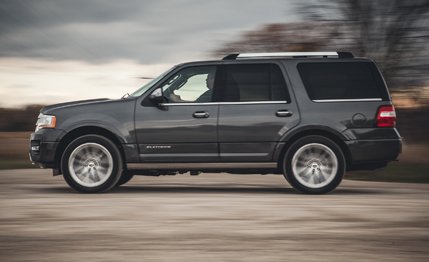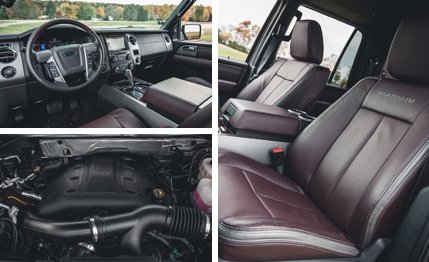
 Instrumented Test
Instrumented Test
Elbowed out of the limelight for 2015 by rock-star Mustangs and F-150s, Ford’s face-lifted Expedition has earned minimal hoopla. But cheaper gas and a recovering economy have spurred full-size SUV sales, so the timing is right for the largest sport-ute wearing the blue oval to win more customers seeking maximum seating and towing capabilities.
Cosmetic changes to the 2015 Expedition include a more tasteful front-end motif with new headlamps, less chrome, and carryover sheetmetal. The liftgate is also fresh this year.
More significant change is under the hood. Forging ahead with EcoBoost technology, Ford has retired the Expedition’s V-8 and replaced it with a twin-turbocharged, direct-injected 3.5-liter DOHC V-6. The boosted V-6 provides an adequate 365 horsepower (55 more than last year) and a daunting 420 lb-ft of torque (55 lb-ft more than the outgoing, 5.4-liter V-8). With a torque peak lowered to a handy 2500 rpm, a gentle brush of the throttle delivers an endearing swell of thrust that seldom requires downshift assistance from the six-speed automatic transmission. With torque instead of horsepower as your ally, cruising in a higher gear is practical, reducing fuel consumption and driveline noise. EPA estimates rise by 2 mpg—both city and highway—to 15/20 mpg with four-wheel drive. Part of that gain, however, is attributable to new electric power steering. As usual, actual road feel is not included. Aiding the comfort side of the equation, Ford has blessed the Expedition with acoustic glass, improved door seals, and additional noise insulation.


The run to 60 mph takes 6.4 seconds, granting the Expedition eligibility for visits to the passing lane. Hitched to a 26-foot, 7000-pound load—a ski boat on a trailer—this husky hauler demonstrated an affinity for towing; it yanked that heavy load with effortless ease. Ford says you can pull up to 9200 pounds with this Expedition. Know, however, that Ford’s rating may not be directly comparable to those of competitors who comply with SAE tow standards, as Ford has not yet signed onto that pact.
The special feature that has long distinguished the Expedition from its U.S. rivals in the mega-family-hauling class is its independent rear suspension. Mounting the rear differential to the frame instead of allowing it to bounce along with the wheels adds weight and cost, but the approach brings several key advantages. Rough-pavement ride is improved and the Expedition feels more stable in bumpy corners. But the biggest gain over a live axle is superior packaging; this vehicle’s floor, frame, and fuel tank can be nested more tightly, yielding more seating and cargo space. Compared with a Chevy Tahoe or a GMC Yukon, the standard-wheelbase Expedition tested here provides far more comfortable third-row seating (for three) and 19—instead of 15—cubic feet of cargo space with all seats in place.
Expeditions are offered in regular (119.0-inch) and extralong (131.0-inch) wheelbases. Both versions overfill a traffic lane with 91.8 inches of width (including mirrors) and stand 77.2 inches tall. Those who enjoy “command” seating will appreciate the two-step climb aboard, facilitated by power-operated running boards that neatly retract into the body sills. There are, however, downsides with this equipment. The steps occasionally inflict shin bruises, and they can stain trousers because dirt deposits are not flushed during trips through the car wash. And fixing this hardware is sure to be expensive if a malfunction occurs out of warranty.


Trim choices have been augmented this year, with the Platinum we tested here added above the previous XLT, Limited, and King Ranch equipment levels. Perforated, French-stitched leather is part of the Platinum package in a choice of two colors: Brunello (think red wine) and Ebony. Both include gray-toned accent strips. While the hide is lovely to touch and these seats are heated and cooled for year-round comfort, there are still vast tracks of rock-hard plastic on the dash, console, and door panels. That’s disappointing in a version that starts near $60,000 and a flaw not usually found in the grand import SUVs (Infiniti QX80, Lexus LX570, Mercedes-Benz GL, Toyota Sequoia).
Our test ute’s three rows of seats provided impressive room and comfort for eight adults and a load floor large enough to tote four-by-eight-foot sheets of building materials (carried flat but with the hatch ajar). Maximizing hauling space involves a two-step fold-and-drop procedure for the split, second-row chairs. While that’s not difficult, most children lack the strength and know-how to return the whole perch from cargo mode to the regular seating position. The solution would be to provide power assistance for the second row, similar to what is included for folding the third-row seatbacks.
One area where the Expedition surges ahead of its traditional rivals is in electronic technology. Twin 4.2-inch color displays fill the instrument cluster with a selectable set of information ranging far beyond road and engine speed and fuel-related data. The 8.0-inch screen centered on the dash above the console is programmed with an improved version of Sync with MyFord Touch. Conventional volume and tuning knobs are provided, and overall operation is significantly better than the version Ford foisted on customers four years ago. One remaining gripe is that screen touch points are still too small to hit accurately when the Expedition is on the move. (We’ll welcome the all-new infotainment setup called Sync 3 that Ford is launching in the near future.)


Also new this year is optional blind-spot sensing with cross-traffic alert, especially handy when the forest of headrests obstructs your vision. Fore and aft parking sensors, while not new, are also useful when docking this cruise ship. Another essential is the backup camera, which takes the heartache out of trailer hook-up procedures.
Our Expedition was equipped with a new $2180 option consisting of 22-inch polished-aluminum wheels, which sound preposterous but wear well on this big guy, as well as a three-mode adjustable damping system. A group of chassis sensors helps adjust shock control as needed every few milliseconds. The beauty of this equipment—which is a first for Ford-branded vehicles—is a pleasant ride whether or not you fiddle with the Comfort, Normal, and Sport settings found in the instrument-cluster menus.
One major ingredient missing in the Ford Expedition is any hint of traditional go, stop, and turn amusement. Although it’s a bitter pill that sports cars don’t come in three-plus-ton sizes, the saving grace is all the camping, boating, and mountain-climbing fun enabled by this king of the sprawling-SUV class.